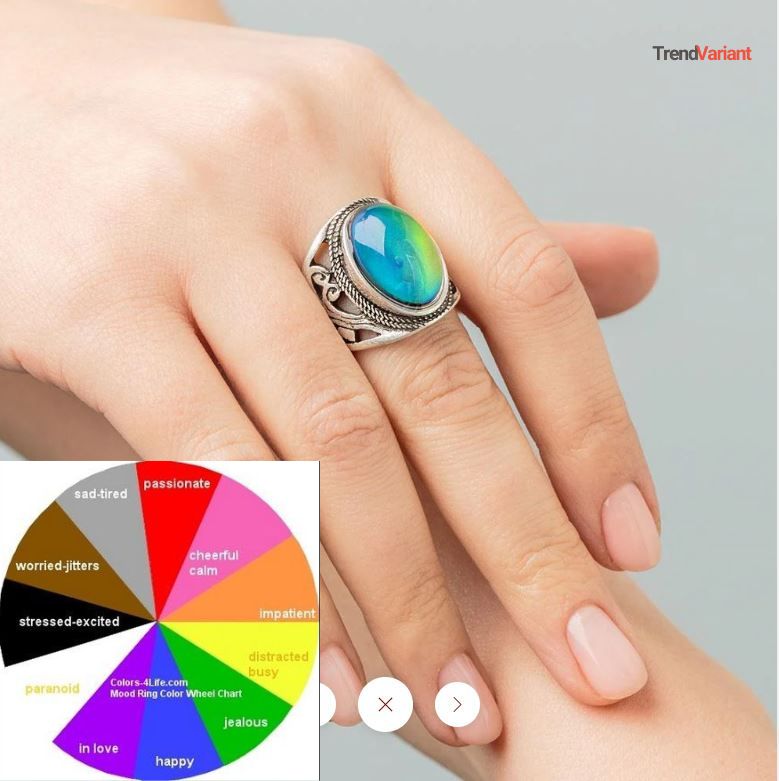Mood rings have fascinated generations with their ability to change colors in response to the wearer’s emotions. These quirky pieces of jewelry have been more than just fashion accessories; they are tiny, mesmerizing mood indicators. In this article, we will dive into the enchanting world of mood ring colors, exploring their history, how they work, what the colors mean, and whether they can truly reflect our emotions.

History of Mood Ring Colors
Mood rings, now regarded as a novelty, had their heyday in the 1970s. The concept behind mood rings, however, dates back to ancient times when people believed that gemstones had the power to influence one’s mood. The modern mood ring as we know it was invented in the 1970s by two New York inventors, Josh Reynolds and Maris Ambats. These rings quickly gained popularity and became an iconic symbol of the era, often associated with the counterculture movement and self-expression.
How Mood Rings Work
The magic behind mood rings lies in the use of thermochromic liquid crystals. These crystals change color in response to temperature variations. When worn, a mood ring’s temperature-sensitive stone is in direct contact with the wearer’s skin, which reflects their body temperature. This change in temperature causes the liquid crystals to shift and display different colors, creating a visually captivating display.
Mood Ring Color Chart
Mood ring colors vary, and each color is associated with a particular emotional state. While interpretations may differ slightly, here’s a general mood ring color chart:
Blue: Relaxed and calm
Green: Content and peaceful
Yellow/Amber: Mixed emotions or anxious
Brown/Gray: Stressed or nervous
Black: Tense or stressed
Red: Excited or passionate
Interpreting these colors can be a fun way to gauge your emotional state at any given moment.
Factors Influencing Mood Ring Colors
Several factors can influence the colors displayed by a mood ring. Temperature fluctuations play a significant role, but individual differences in body heat and environmental factors can also impact the ring’s performance. It’s essential to keep these factors in mind when interpreting mood ring colors.
Fun Facts and Trivia
Mood rings have had their share of quirky stories and fascinating trivia. Some have reported their mood rings changing colors in response to extreme weather conditions, while others have claimed their rings could predict their romantic fortunes.
Celebrity endorsements, like Elvis Presley and Queen Elizabeth II, added to their allure, and they remain nostalgic items for many who grew up in the ’70s and ’80s.
Do Mood Rings Really Reflect Emotions?
While mood rings are entertaining and intriguing, their ability to accurately reflect our emotions is limited. From a scientific standpoint, they primarily respond to temperature changes, not specific emotional states. The relationship between body temperature and emotions is complex and can vary greatly among individuals.
Psychologically, mood rings may provide a form of placebo effect, making wearers more mindful of their emotions and potentially influencing their mood indirectly.
Caring for Mood Rings
To keep your mood ring in the best condition, it’s important to avoid exposure to extreme temperatures and chemicals. Wipe it gently with a soft cloth to maintain its appearance and ensure it continues to change colors accurately.
Contemporary Uses of Mood Ring Colors
Today, mood rings are often seen as a nostalgic and fun fashion accessory. While they may not be taken as seriously as they once were, they still hold a unique place in popular culture. Some individuals wear them as a conversation starter, a nod to the past, or simply as a lighthearted reminder to pay attention to their emotional well-being.
Table of Contents
Conclusion
Mood rings have captured the imagination of generations with their intriguing color-changing abilities. While they may not be scientifically precise mood indicators, they continue to hold a special place in our hearts as reminders of a bygone era of self-expression and fashion experimentation. So, next time you slip on a mood ring and watch it change colors, remember that it’s not just a piece of jewelry but a tiny, colorful window into your emotional world. (TIME two NEWS)









